The Checker Maven
A Friendly Sitting

Our title for today's column comes from a rather old checker magazine, which states that the problem situation shown below came from an informal or "friendly" match played somewhere in Ohio back in the day. Certainly, checkers can be a most sociable pastime, and we would hope that we can all be friends, even given the rather intense competition and rivalries that the game can often engender.
The problem itself, of course, is rather "friendly" in its own right, and we don't think that you'll have a lot of trouble solving it.
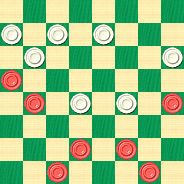
BLACK
Black to Play and Win
B:W28,27,26,24,21,15,14:B20,16,13,7,6,3,1.
Sit down, make friends with the problem, and then click on Read More to see the most agreeable solution.![]()
Henderson's Shot

As we continue our regular columns taken from Willie Ryan's Tricks Traps & Shots of the Checkerboard, this month we come to a situation that's a bit different. This time, Black plays a move that is good enough to draw, but only if he can find a spectacular shot--- of the checker variety, that is!
Here's Willie once again to tell us how it all takes place.
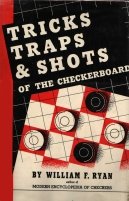
"Scotland has given birth to many of the World's great draughts players. Among them was Hugh Henderson of Muirkirk, who emigrated to America in 1910, settling down in Pittsburgh, Pennsylvania. He won the American Championship tournaments of 1912 and 1915, and for many years edited a widely read checker column in the Pittsburgh Leader, in which he revealed an immeasurable amount of original scientific play. The Henderson Shot, which we reproduce here, is one of his best-known examples of superscientific play.
| 10-15 | 17-14 | 7-10 |
| 23-18 | 6-9 | 14-7 |
| 12-16 | 24-19---A | 3-19 |
| 26-23 | 15-24 | 32-28---3 |
| 8-12 | 28-19 | 2-7---B |
| 30-26 | 11-16 | 21-17 |
| 16-20 | 25-21 | 7-10* |
| 21-17 | 1-6---2 | 29-25. |
| 9-13 | 19-15 | See the |
| diagram |
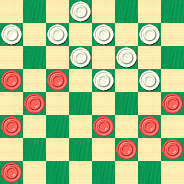
BLACK
Black to Play and Draw
B:W31,28,27,26,25,23,22,18,17:B20,19,16,13,12,10,9,6,5,4.
A---Black has a well-known one-move knockout if white tries 23-19 here, since 13-17! wins at once---1.
B---After this move, black's only out is via the Henderson Shot. Instead of 2-7, black has an easier road to a draw by 9-14!---4, 18-9, 5-14, 22-17, 13-22, 26-1, 19-26, 31-22, 16-19, 1-5, 12-16, 5-9, 4-8, 9-14, 8-12. L. C. Ginsberg."
1---Either 19-10 17-21 24-19 (other moves are possible but also lose) 21-30 26-23 11-15 18-11 9-25 29-22 7-14 Black Wins, or else 22-6? 1-17 19-10 7-30 Black Wins---Ed.
2---2-6 is preferred by the computer, who now thinks White has a tangible, though certainly not decisive, edge.---Ed.
3---Instead, 18-15 looks quite strong for White. The text move allows Black to get back in the game on the next move---Ed.
4---The computer finds that 4-8, among others, also draw. Of course, some draws are much easier to find over the board than others---Ed.
Black has made life difficult for himself. Can you help him out by finding the shot that leads to a draw? The play is not easy, but it can be done. Take a "shot" at it and then aim your mouse at Read More to see Willie's solution.![]()
New PDN Files Available

Thanks to the generosity and hard work of Checker Maven friend John Acker, we have a number of new PDN files available for your instruction and entertainment. Just click on the PDN link in the Downloads section in the right column, or click here.
Don't know about PDN files or how to use them? You'll find an explanatory link on the PDN download page.
Enjoy these new files, and again, thank you John!![]()
Negative Second Position

The concept of negative numbers is said to be due to the Hindu mathematician Brahmagupta, who defined them around the year 600 A.D; but the idea is even older, dating back at least to the Greek mathematician Diophantus, around 250 A.D., who wrote about "forthcomings" and "wantings" to represent the modern idea of positive and negative numbers.
An ancient idea indeed, although most historians believe the foundations of our game of checkers go back even further!
And this brings us to the point of today's Checker School session: a situation which as been referred to as Negative Second Position. No doubt you're familiar with the basics of the Second Position ending (it's been covered in a previous Checker School lesson); today's position changes, or perhaps negates, the value of a few of the pieces, changing White to Black, King to man, and vice-versa. If that's confusing, a look at the diagrammed position, attributed to W. Strickland, will clear it all up.
WHITE
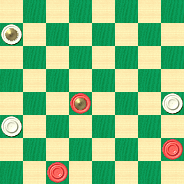
BLACK
Black to Play and Win
B:WK28,13,12:BK15,5,3.
Can you negate the difficulty of this problem and find the win? A negative attitude will never do! Think positively, find the answer, and then be certain to click on Read More to see the solution, a sample game, and detailed notes.![]()
Welcoming the New Year

Of course, we're welcoming the New Year on the Jewish calendar --- the year 5769, to be precise, an event celebrated by eating apples dipped in honey and hearing the blowing of the ram's horn, known as the "shofar" and pictured above.
The Checker Maven celebrates by bringing you an interesting (and not very difficult) checker problem in which all is not as it seems, and the obvious may not be obvious at all. Here's our position.
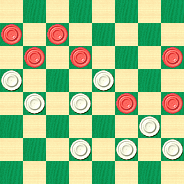
WHITE
White to Play and Win
W:W28,27,26,24,18,17,15,13:B20,19,12,10,9,6,5.
White is a man up, so why are we blowing our horn over this one, you may ask. Well, although the New Year has come quickly upon us as it always seems to do, haste is not advised in making your move here.
See if you can find the win--- as we said, it's not very difficult--- and also demonstrate what's wrong with the "obvious" move. Blow your own horn and then click on Read More for the complete solution. And have a good and a sweet year!![]()
